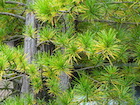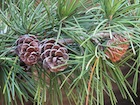Conservation Status

Sciadopitys verticillata
(Thunberg) Siebold et Zuccarini 1842
Common names
Umbrella pine, Japanese umbrella pine; KOYA-MAKI, コウヤマキ, 高野槙 [Japanese].
Taxonomic notes
The sole species in Sciadopityaceae Luerss. 1877 and Sciadopitys Siebold & Zuccarini 1842. Basionym Taxus verticillata Thunberg 1784. Syn. Podocarpus verticillatus (Thunb.) Wall. ex Steud. 1841 (Farjon 1998).
The family was formerly included as a genus within Cupressaceae (Taxodiaceae), but recent genetic studies (e.g., Brunsfeld et al. 1994) have shown that it is clearly not allied with that group. The family is elevated to the rank of Order by some authors; Sciadopityales Takht. ex Reveal 1993. Relationships remain unclear, but there is some suggestion of a distant alliance to the Podocarpaceae, supported by wood structure and cpDNA analysis (Brunsfeld et al. 1994).
Description
An evergreen tree to 20-30(35) m tall and up to 1 m dbh, with dense, heavy branching and luxuriant foliage, single- or multi-stemmed. Bark thick soft red-brown, stringy. Shoots orange-brown, glabrous, dimorphic (long or short); buds ovoid, 3-4 mm, only produced at the shoot apices. Leaves of two types, scale leaves on the stem, brown, 1-3 mm, widely spaced between the nodes on long shoots, and clustered in a tight spiral pseudowhorl subtending the photosynthetic leaves at the apex of both long and short shoots. Photosynthetic leaves variously interpreted as a pair of true leaves fused together, or as highly modified shoots (cladodes); linear, in pseudowhorls of 10-30 at the shoot nodes, 6-13 cm long, 2-3 mm wide, 1 mm thick, heavy, fleshy, pliable, with a prominent mid-line groove on both sides; rich glossy green with a pale stomatal line each side of the mid-line groove on the underside; persistent 3-4 years. Pollen cones 6-12 mm, in dense terminal clusters 1-2 cm across. Seed cones subsessile, ovoid, green ripening dark brown in 18-20 months from pollination, 4.5-10 cm long, 3.5-6.5 cm wide when open; fragile and breaking up soon after seed release. Fertile scales 15-40 per cone, thin, flat to upcurved, 2-3 cm long, 2-3.5 cm wide, rough, matt, with a broad flap-like transverse bract lateral across most of the width of the scale at its widest point; apex rounded, irregularly waved. Seeds 5-9 per scale, orange-brown, 8-12 mm long, flattened ovoid with a narrow wing along each side of the seed and notched at the apex. Cotyledons 2. Chromosomes n = 10 (Dallimore et al. 1967, Rushforth 1987, Frankis 1988, C.N. Page in Kubitzky 1990, Vidakovic 1991). Forms a vesicular-arbuscular mycorrhiza (Maeda 1954, cited by Brundrett 2008). See García Esteban et al. (2004) for a detailed characterization of the wood anatomy.
Distribution and Ecology
Japan: S Honshu, Kyushu and Shikoku. Occurs in mixed middle altitude cloud forest at 500-1000 m, with high rainfall and humidity (Dallimore et al. 1967, C.N. Page in Kubitzky 1990).
Distribution of Sciadopityaceae. Source, GBIF (2021).
Conservation status is "Near Threatened". Despite the value of its wood, its slow growth has led to a decline in planting in Japanese forests in favour of faster-growing species like Cryptomeria japonica.
Remarkable Specimens
The largest and oldest known specimen seems to be a tree at Jinguji Temple, Koaza Himejitani Aza Ishikawa, Town of Nodagawa, Kyoto Prefecture is 27 meters tall and has a girth of 4.1 meters. "A tree with origins obscured in the distant past, historical records show that it has been worshipped locally since 1310, when a monk from Ishiyamatera Temple (in Otsu-City), renovated this temple located in the Ishikawa region and named it Jinguji Temple. Legend says the principal Buddhist image of the temple is a woman, which is why people, attending the annual festival, touch the Umbrella-Pine in hopes of being blessed with healthy children. The Umbrella-Pine of Junguji Temple has been designated as a natural monument (plant) of Kyoto Prefecture" (Kyoto Nature 2000).
Ethnobotany
In Japan, the spicy-scented, water-resistant wood is highly valued for making boats; its bark, in the form of oakum, is used for caulking (Britannica Online).
It is one of the 'five trees of Kiso' treated as sacred in Japan (Dallimore et al. 1967).
Sciadopitys makes a very attractive ornamental, with luxuriant rich green foliage and orange-brown bark, but it requires high rainfall and warm, humid summers for good growth (USDA hardiness zone 7). Also, like Ginkgo (Ginkgo biloba), it is a good tree to grow as a 'conversation piece', with a history dating from the earliest days of the dinosaurs.
Observations
Most botanical gardens and arboreta in subtropical to temperate climates will have specimens, and they are locally popular ornamentals; there is a potted tree outside my local shopping mall.
Remarks
The genus name is derived from the Greek words for "canopy" and "pine", thus, "umbrella pine". The epithet refers to the whorled cladodes.
It is an ancient endemic with a highly relictual range; the prehistoric range of the family was far more extensive across both Eurasia and North America, with fossils dating back to the upper Triassic. Among the oldest of all extant conifers, and already in decline by the time other 'ancient' conifers became widespread in the lower Cretaceous (C.N. Page in Kubitzky 1990), it is a true 'living fossil'.
This species forms old-growth forests with Chamaecyparis obtusa. Seedlings can regenerate beneath the forest canopy, although small gaps with exposed mineral soils constitute preferred establishment sites (Yamamoto 1988).
Citations
Brundrett, Mark. 2008. Mycorrhizal Associations: The Web Resource. mycorrhizas.info, accessed 2009.06.09.
Frankis, M.P. Pers. obs. of cultivated trees in Britain, reported 1998.02.21.
GBIF.org (2021.11.12) GBIF Occurrence Download https://doi.org/10.15468/dl.874zh4
Kyoto Nature: 200 Glimpses. http://www.pref.kyoto.jp/intro/21cent/kankyo/200/jk30e.html, accessed 2000.01.25, now defunct.
Maeda, M. 1954. The meaning of mycorrhiza in regard to systematic botany. Kumamoto Journal of Science, Series B 3: 57-84.
Yamamoto, S.I. 1988. Seedling recruitment of Chamaecyparis obtusa and Sciadopitys verticillata in different microenvironments in an old-growth Sciadopitys verticillata forest. Botanical Magazine of Tokyo 101(1061):61-71.
Thanks to M.P. Frankis for preparing the description and much supplementary material, 1999.02.
See also
Elwes and Henry 1906-1913 at the Biodiversity Heritage Library. This series of volumes, privately printed, provides some of the most engaging descriptions of conifers ever published. Although they only treat species cultivated in the U.K. and Ireland, and the taxonomy is a bit dated, still these accounts are thorough, treating such topics as species description, range, varieties, exceptionally old or tall specimens, remarkable trees, and cultivation. Despite being over a century old, they are generally accurate, and are illustrated with some remarkable photographs and lithographs.
Farjon (2005) provides a detailed account, with illustrations.
Fu, Yu and Farjon (1999).
Hayata B. 1931. The Sciadopityaceae represented by Sciadopitys verticillata Sieb. et Zucc. an endemic species of Japan. Botanical Magazine of Tokyo 45: 567-569.






